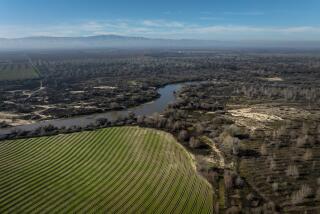After Flood, a Tide of Red Ink for Farmers
As Northern California farmers continued Monday to mop up homes, barns and milking parlors, officials and economists scurried to tally the damage to the state’s $20-billion agriculture industry.
Most agreed that it is far too early to tell just how high the damage toll will run for farmers, though it obviously will be considerable and some individual farmers might be wiped out.
Water from breached levees has gushed onto the fields and inundated the orchards of scores of farmers. Untold tons of topsoil have washed away, sweeping off tens of thousands of seedlings of winter wheat and other grains. Some dairy farmers have suffered a devastating loss of milking cows.
For the time being, farm experts figure, these losses will not automatically translate into higher grocery bills. Retail food prices only minimally reflect farmers’ costs. Consider that the farmer’s take on a $2.50 loaf of bread can be as low as 10 cents.
Even if a farmer wanted to pass along his costs for repairs or lost production, chances are the supply-and-demand forces of the global market would make that impossible. So it is likely, economists say, that farmers, many of them uninsured for flood damage, will be forced to bear their own financial burdens or turn to the government for help.
From the Redwood Coast to the San Joaquin Valley, farmers face the daunting challenge of refurbishing equipment, filling in gulleys, re-leveling fields, cleaning out wells, removing fallen trees and reinstalling irrigation equipment.
“A case of severe property damage will be the main agricultural impact for growers,” said Dave Kranz, a spokesman for the California Farm Bureau Federation in Sacramento. “There’s not only the cost of cleanup but also the time it takes.
“These are logistical things that . . . call you away from normal operations. Normally, you’d be out working the land to get it ready [for planting]. This disrupts everything.”
And, Kranz noted, “We still have three months of rainy season left. It’s often the weather immediately following the storm that makes the difference.”
As bad as the flooding has been in some areas, there is some good news about the timing for farmers and consumers: Orchards and vineyards are dormant, so plants will not suffer the same ill effects as in March 1995, when strong rains and winds thinned out buds, diminished yields and toppled almond trees.
Important winter vegetables such as lettuce, broccoli and cauliflower are grown primarily in the desert regions of Southern California and Arizona, which so far have been relatively unaffected by weather. And the state’s crops of winter wheat, barley, oats and alfalfa--though important to some individual farmers for feed--are grown in relatively small quantities in Northern California.
Row-crop farmers are suffering in the flood zone even though they had yet to plant. One Stanislaus County tomato grower with a 2,000-acre farm spent $40 an acre fertilizing his fields for planting tomatoes. All that prep work has been washed away.
Here is an early assessment of some other key commodities:
* Milk. Most of the state’s largest dairies are in Tulare County and Southern California, which were spared the nastiest rain and flooding. But several small dairies near Sacramento were harshly affected.
Some farmers could not milk their cows because of power interruptions. If cows are not milked regularly, they can stop producing and sometimes must go through another calving cycle before resuming production--a process that can take a year.
“Production at some dairies will be off for a while,” said Case van Steyn, owner of Van Steyn Dairy in Elk Grove. “It could be way down and some farmers might go out of business.” But he estimated that just 2% to 5% of the state’s dairies were directly affected by the flooding.
* Winter wheat. About 150,000 acres have been affected, with an undetermined amount of loss. Bonnie Fernandez, executive director of the California Wheat Commission, said that wheat, a grass, “can take some water.” Even if there is great damage, she said, it probably won’t have much effect on consumer prices. California grows just 2% to 3% of the nation’s wheat.
But reduced production of hay could cause feed prices to spike, compounding dairy farmers’ woes.
* Almonds. The region’s almond trees probably are OK for now because they are dormant, said Dave Baker, director of member relations for Blue Diamond Growers, a 4,000-member almond cooperative in Salida, Calif. Flooding during the growing season would present a greater danger of rot, disease or asphyxiation of the roots, said Warren Micke, a pomologist, or expert on deciduous trees, at UC Davis.
“If it’s got to happen, from the tree standpoint this is as good a time as any,” Micke said, “even though it was disastrous for a lot of people.”
(BEGIN TEXT OF INFOBOX / INFOGRAPHIC)
Cleaning Up
As flood waters recede, residents face the arduous task of cleaning up their homes. Here are a few tips:
* Be sure it is safe to go inside. Inspect foundations, walls and ceilings for cracks and sagging. Stay out if flood waters remain around building.
* Turn off electrical power at breaker or fuse box, even if the utility company has turned off power to the neighborhood. If you have to step in water to reach the box, call an electrician.
* If you smell gas, leave the building. Turn off gas at outside main valve or call the gas company.
* Check water pipes. If pipes are not damaged, tap water can be used for some cleaning, but not for domestic uses such as cooking.
* Use battery-powered lanterns or flashlights, not lighters or other open flames.
* Watch for animals, especially poisonous snakes that may have come inside. Use a stick to poke through debris.
* Every flooded part of the house should be thoroughly cleaned and disinfected.
* Ventilate your home. Open doors, windows, cabinets and closets. Heating the building may help. Use fans, dehumidifiers and desiccants (materials that absorb moisture). Water pumps and vacuums can be rented. For expert help, look in the telephone book under Fire and Water Damage Restoration. Beware of unscrupulous contractors.
* Shovel out mud before it dries; it may contain contaminants.
* Use a mop, wet-dry vacuum or squeegee to remove water from floors. Don’t use regular vacuum cleaners on wet floors.
* Upholstered furniture, drapes and carpets should be professionally cleaned or discarded.
* Clothing and linens should be thoroughly washed or dry-cleaned. Hose off muddy items to remove all dirt before putting in washer.
* Throw away food and medicine saturated by flood waters, including canned foods.
* Pump out basements gradually to avoid structural damage.
* Wash mud off valuables before the soil dries. Some items, such as photographs, can be frozen and repaired later.
* Wash hands with soap and water after cleaning up or handling flood-contaminated articles.
Researched by NONA YATES / Los Angeles Times
SOURCES: American Red Cross; Federal Emergency Management Agency, California Energy Commission
More to Read
Sign up for Essential California
The most important California stories and recommendations in your inbox every morning.
You may occasionally receive promotional content from the Los Angeles Times.











